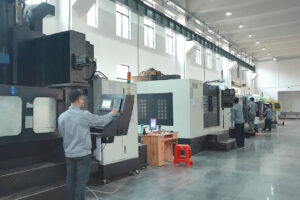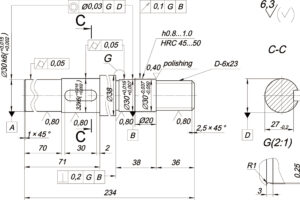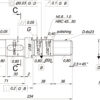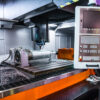What is CNC machining?
CNC machining is a process in which the control system issues commands to make the tool perform various movements that meet the requirements and express the shape and size of the workpiece in the form of numbers and letters. It generally refers to the process of machining parts on CNC machine tools.
A CNC machine tool is a machine tool controlled by a computer. The computer used to control the machine tool, whether a dedicated computer or a general-purpose computer, is collectively referred to as a numerical control system. The movement and auxiliary actions of CNC machine tools are controlled by the commands issued by the CNC system. The programmer compiles the CNC system’s instructions according to the workpiece’s material, the processing requirements, the characteristics of the machine tool, and the instruction format (NC language or symbols) specified by the system. The numerical control system sends running or termination information to the servo device and other functional components according to the program instructions to control various movements of the machine tool. When the machining program of the part ends, the machine will automatically stop. If there is no program command input in its CNC system for any CNC machine tool, the CNC machine tool cannot work.
The controlled actions of CNC machine tools generally include the start and stop of the machine tool; the start and stop of the spindle, the transformation of the rotation direction and speed; the direction, speed, and method of the feed movement; the selection of the tool, the compensation of the length and radius; the replacement of the tool, Turning on and off the coolant, etc.
5 advantages of CNC machining:
1.Process concentration
CNC machine tools generally have tool holders and magazines that can automatically change tools. The program automatically controls the tool changing process, so the process is relatively concentrated. Process concentration brings huge economic benefits:
- Reduce the floor space of the machine tool and save the workshop.
- Reduce or no intermediate links (such as intermediate testing of semi-finished products, temporary storage and handling, etc.), saving time and workforce.
2.Automation
When CNC machine tools are processed, there is no need to control the tool manually, and the degree of automation is high. The benefits are obvious.
Reduced requirements for operators:
- A senior worker of an ordinary machine tool cannot be trained in a short time. In contrast, a CNC worker who does not need programming takes a very short training time (for example, a CNC lathe worker needs a week, and a simple machining program can be written). Moreover, the parts processed by CNC workers on CNC machine tools have higher precision and save time than those processed by ordinary workers on traditional machine tools.
- Reduce the labour intensity of workers: CNC workers are excluded from the processing process most of the time during the processing process, which is very labour-saving.
- Stable product quality: The processing automation of CNC machine tools eliminates human errors such as fatigue, carelessness, and estimation of workers on ordinary machine tools and improves product consistency.
- High processing efficiency: The automatic tool change of CNC machine tools makes the processing process compact and improves labour productivity.
3.Strong ability
Machine tools can accurately machine various contours, and some contours cannot be machined on ordinary machine tools. CNC machine tools are especially suitable for the following occasions:
- Parts that are not allowed to be scrapped.
- New product development.
- Processing of urgently needed parts.
4.There are many types of CNC machining
Modern CNC machine tools are suitable for various cutting methods. CNC turning machining makes it possible to manufacture complex exterior and interior geometries. For example, CNC turning and CNC milling. During CNC turning, the raw material is machined as the machining progresses, making it possible to manufacture complex external and internal geometries, including the generation of various threads.
CNC milling is better for making holes, slots, and repetitive movements to create complex three-dimensional shapes. Milling is versatile and easy to set up repetitive motions and is often used to make plastic injection molding molds.
5.Security
Although the operator plays an important role in CNC machining, the operator does not operate the machine by hand but on the computer. This creates a safer work environment for all and reduces workplace accidents.
This is especially important because workers performed repetitive manual labour in the past. CNC machining ensures that the resulting product is consistent and meets quality control guidelines. Human error and lack of sleep are the common hidden danger, leading to accidents, and there is no need to worry about CNC machining.







